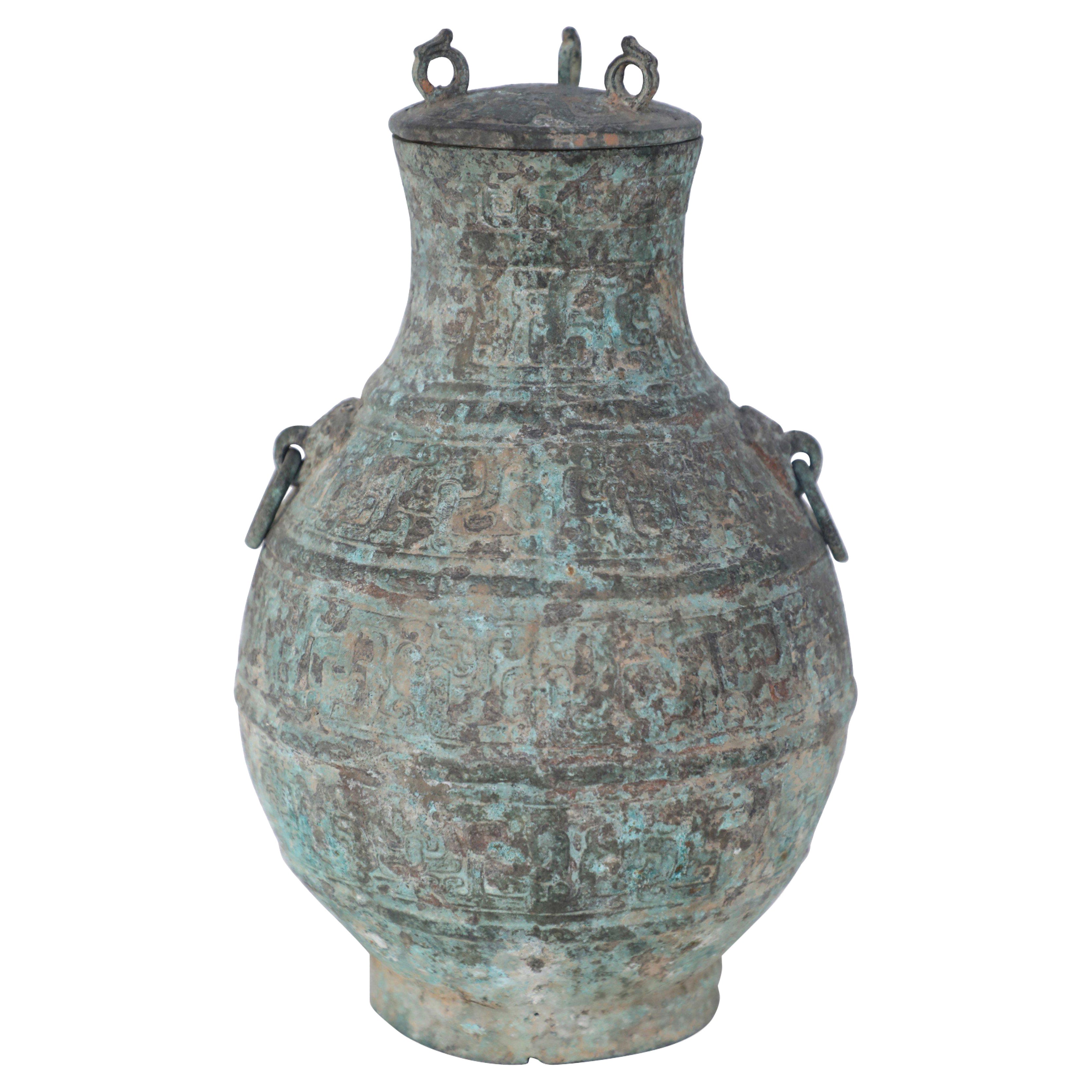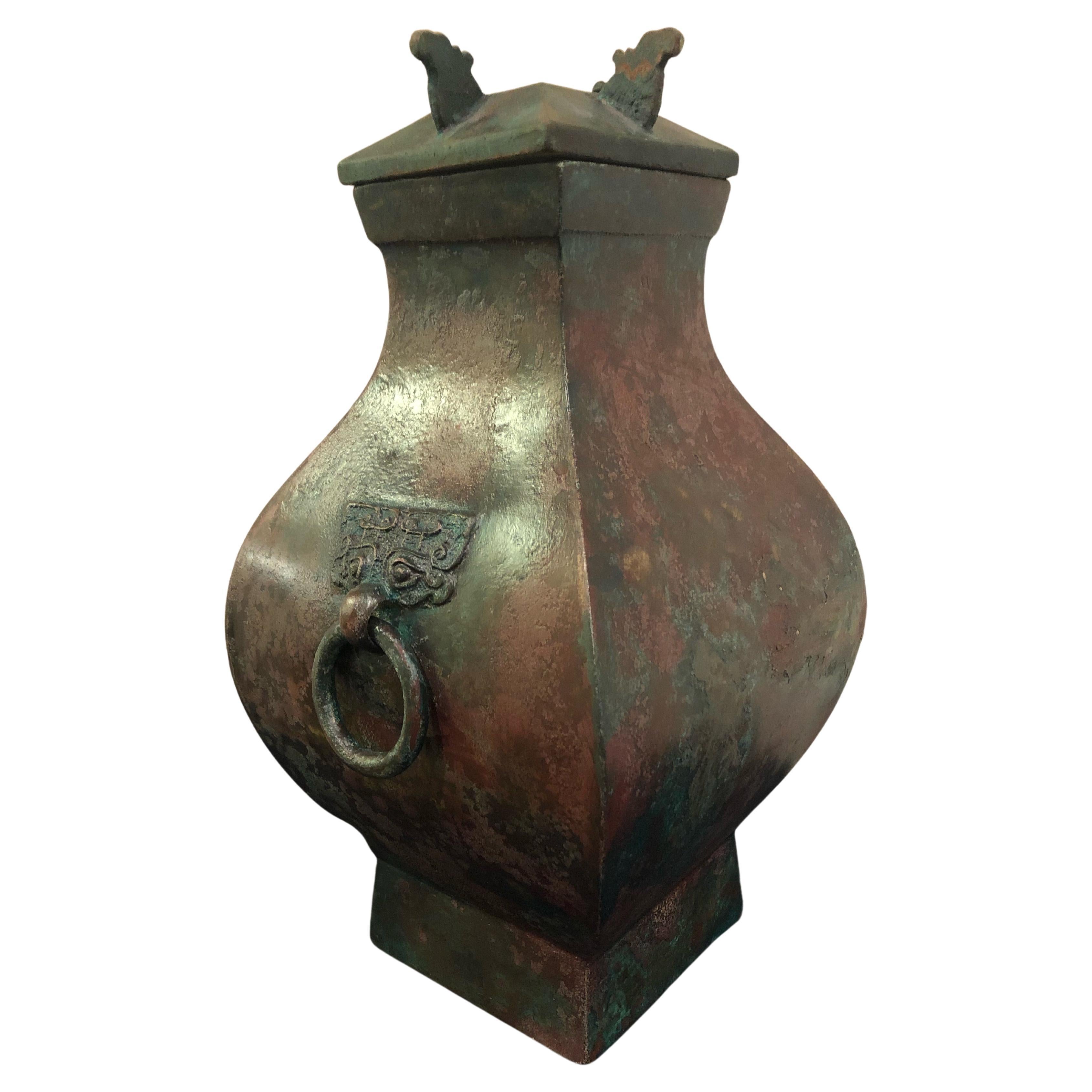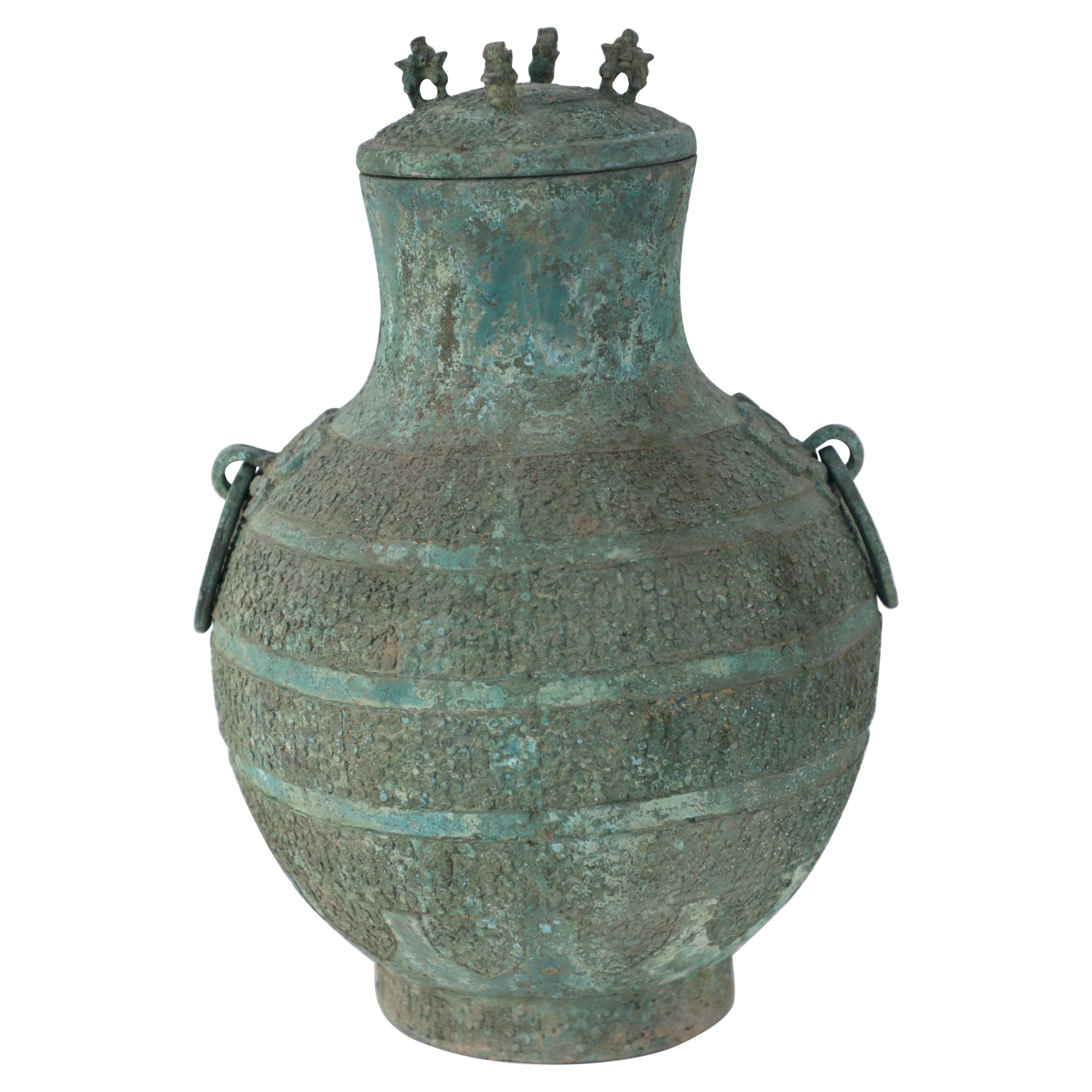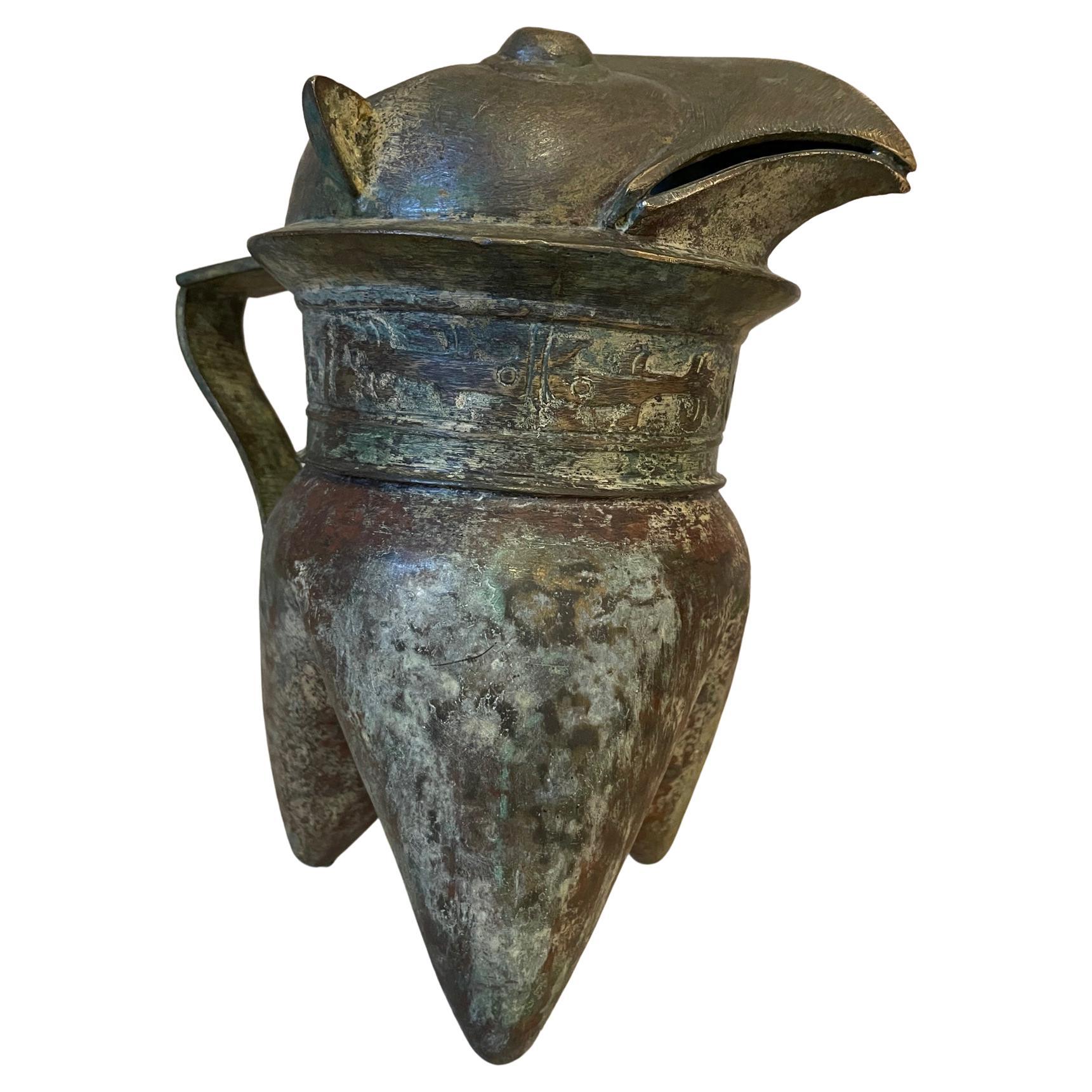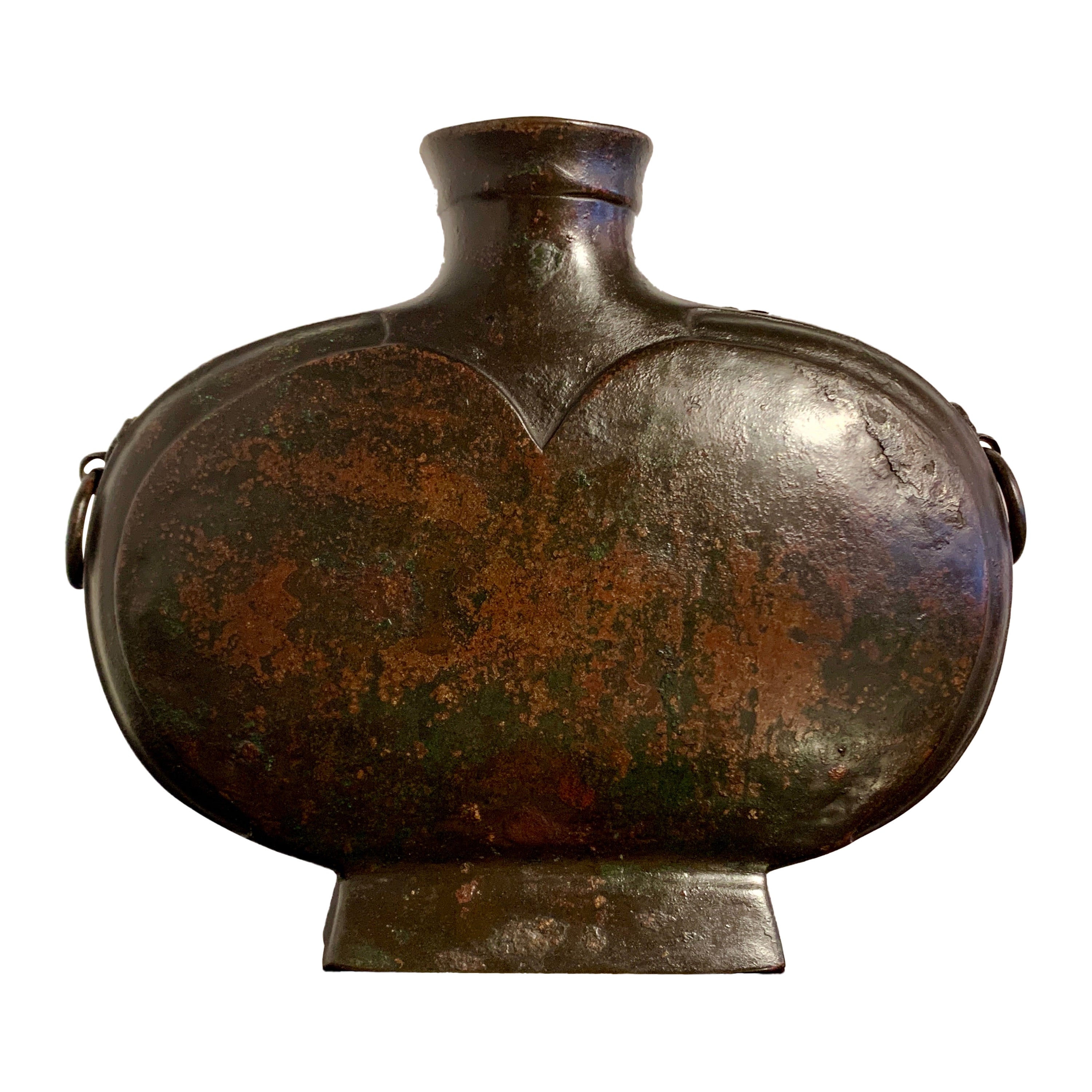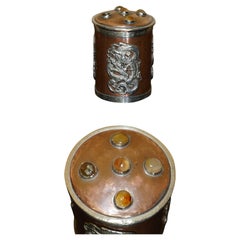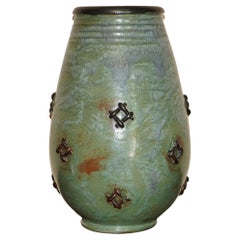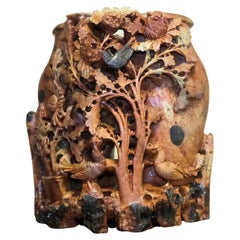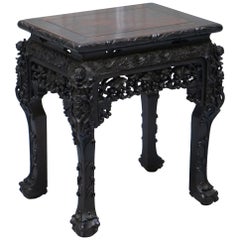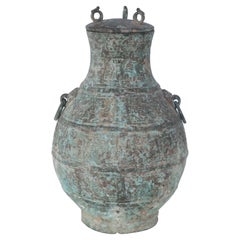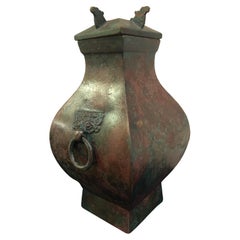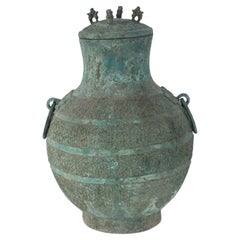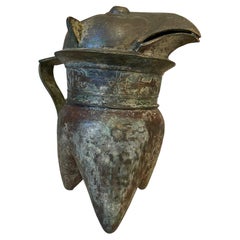Items Similar to Fanghu Han Dynasty 206BC-220AD Chinese Bronze Ritual Wine Vessel Jug & Cover
Want more images or videos?
Request additional images or videos from the seller
1 of 16
Fanghu Han Dynasty 206BC-220AD Chinese Bronze Ritual Wine Vessel Jug & Cover
$28,576.69
$40,823.8430% Off
£21,000
£30,00030% Off
€24,671.51
€35,245.0230% Off
CA$39,259.51
CA$56,085.0230% Off
A$43,829.55
A$62,613.6530% Off
CHF 22,966.03
CHF 32,808.6130% Off
MX$536,516.76
MX$766,452.5130% Off
NOK 291,668.77
NOK 416,669.6830% Off
SEK 275,006.62
SEK 392,866.6030% Off
DKK 184,126.04
DKK 263,037.1930% Off
About the Item
We are delighted to offer for sale this exceptionally important and highly collectable museum quality original Chinese bronze ritual wine vessel and cover, Fanghu Han Dynasty 206BC-220AD with Taotie mask handles - olive green and russet patina with specks of malachite encrustation
The quadrangular wine jar is raised on a high pyramidal foot. Two sides of the vessel are embellished with a crisply cast taotie-mask, through the nose of which a movable ring is placed. The mouth rim is accentuated with a narrow raised band. The square cover has a flat top and each side is applied with a bird-form finial that convert to supports when the cover is inverted. The vase has an attractive olive-green and russet patina and has some bright specks of malachite encrustation. The patina and encrustation enhance the beauty of the vase and make it interesting to look at: each side has its own appearance.
The taotie-mask is one of the most distinctive and characteristic images in Chinese art, originating from Shang ritual bronzes and becoming a much-used decoration in later dynasties: not only in bronze but also on other art-forms such as porcelain. The primary attribute of this frontal animal-like mask is a prominent pair of eyes, often protruding in high relief. Between the eyes is a nose, often with nostrils at the base. Taotie can also include jaws and fangs, horns, ears, and eyebrows. Many versions include a split animal-like body with legs and tail, each flank shown in profile on either side of the mask. While following a general form, the appearance and specific components of taotie masks varied by period and place of production. Is is thought that the taotie is a protective symbol. It is likely that the present fanghu is applied with these masks to protect the deceased in his grave and on his journey to the spirit world.
In terms of the condition its exactly as you would expect to find a piece 1800-2200 years old that has spent hundreds of years buried, there is one small loss to the top, otherwise it is a sublime museum quality example
Dimensions:
Height 35cm
Width 18.5cm
Depth 19.5cm
Please note all measurements are taken at the widest point
Chinese bronzes
In China bronzes first appeared in the Erlitou Culture (circa 2100-1600 BC), mainly in the form of libation vessels, jue, yet in the glorious days of the Bronze Age, during the Shang (circa 1700-1050 BC) and Zhou (1050-221 BC) dynasties, the quality of the casting of bronze was at its height. Not only bronze weapons were made with which the Shang and Zhou controlled peoples around them, but also much attention was paid by casters and their patrons to vessels in which food and wine were offered to ancestors. Most of these bronzes may be described as ritual vessels intended for the worship of ancestors, who are often named in inscriptions on the bronzes. These ritual vessels of ancient China represent possibly the most remarkable achievement in the whole history of metalcraft before modern times.
Bronze vases should not be considered individually but in groups as ritual sets. These sets are defined as the range of vessel types required for the correct performance of rituals. The combination of these vessels can be inferred from two sources, intact tomb groups and vessels that share a common dedication. From the arrangement and quantity of bronzes displayed in a given ceremony, one can discern the specific social status and position of that noble host. In the case of vessels interred in tombs it seems likely that the occupant of the tomb was expected to continue to offer sacrifices to his ancestors after his death and that vessels were buried for this purpose, even though he had become an ancestor himself. It is also possible that they were used at funerary rites. Besides their use in ancestral worship, rites of spirit worship and as symbols of status and power, bronzes could, it was believed, when buried with the deceased, continue to serve in the afterlife. As some aristocrats and all commoners at the time could not afford the expense of bronzes, frequently complete sets of ritual vessels were made in fired pottery.
In the Shang dynasty (circa 1600–1046 BC), the right to cast or possess these vessels was probably confined to the royal house itself but later was bestowed upon local governors set up by the ruler; still later, in the Zhou dynasty (1045–256 BC), the right was claimed by rulers of the feudal states and indeed by anyone who was rich and powerful enough to cast his own vessels. Under the ultimate unification of Qin and Han, Chinese bronzes gradually yielded its central role in the ritual system but transformed into a cultural archetype.
Shapes
Although there are many different shapes in Chinese bronze ritual vessels, they can be reduced to a few essential types used for the ritual of ancestor worship. Vessels were required in which to cook and serve the dishes, to preserve and hold the wine for drinking, and to contain and pour water. They can most simply be grouped according to their use in sacrifices.
Hu: A round-bellied vase or a jar with a cover
You: A ritual wine vessel with a stout oval body and an overhead handle, usually with a cover
Zun: Another ritual wine vessel, flared and with a bulbous mid-section
Gu: Also a ritual wine vessel, similar to the zun but with a slender silhouette
Jue: One of the more striking vessels of the archaic ritual bronze assembly — another ritual wine vessel, with a prominent spout, whorl-capped posts, flared tail and long tripod legs
Ding: A ritual cooking vessel with a globular body, tripod legs and a pair of upright handles
Gui: A ritual food vessel with a compressed globular body, raised on a waisted foot, with a pair of loop handles usually decorated with animal heads Square forms: Many of the standard shapes also appear in ‘square’ or fang versions, including the fangzun, fanghu and fangding. Of great significance to the ancient ruling elites, square vessels are much more rare. Square-sectioned vessels have a more formal and regular appearance.
Today, we see the Chinese bronzes in a very different condition from the original. Their long period underground has covered them with a patina, sometimes rough with encrustations and sometimes smooth like jade. They take on all the shades of green. Often, there are russet, purple or blue patches depending on the chemical changes which affected the metal. These alterations only emphasise the beauty of these bronzes.
This item is available for collection from our Wimbledon warehouses
Condition:
Please view the very detailed pictures as they form part of the description around condition
Please note vintage period and original items such as leather seating will always have natural patina in the form of cracking creasing and wear, we recommend regular waxing to ensure no moisture is lost, also hand dyed leather is not recommended to sit in direct sunlight for prolonged periods of time as it will dry out and fade.
- Dimensions:Height: 13.78 in (35 cm)Width: 7.29 in (18.5 cm)Depth: 7.68 in (19.5 cm)
- Style:Han (Of the Period)
- Materials and Techniques:
- Place of Origin:
- Period:
- Date of Manufacture:206BC-220AD
- Condition:Wear consistent with age and use. Minor losses. Minor structural damages. Minor fading.
- Seller Location:West Sussex, GB
- Reference Number:1stDibs: LU2823319780322
About the Seller
4.7
Platinum Seller
Premium sellers with a 4.7+ rating and 24-hour response times
Established in 2012
1stDibs seller since 2017
1,995 sales on 1stDibs
Typical response time: <1 hour
- ShippingRetrieving quote...Shipping from: West Sussex, United Kingdom
- Return Policy
Authenticity Guarantee
In the unlikely event there’s an issue with an item’s authenticity, contact us within 1 year for a full refund. DetailsMoney-Back Guarantee
If your item is not as described, is damaged in transit, or does not arrive, contact us within 7 days for a full refund. Details24-Hour Cancellation
You have a 24-hour grace period in which to reconsider your purchase, with no questions asked.Vetted Professional Sellers
Our world-class sellers must adhere to strict standards for service and quality, maintaining the integrity of our listings.Price-Match Guarantee
If you find that a seller listed the same item for a lower price elsewhere, we’ll match it.Trusted Global Delivery
Our best-in-class carrier network provides specialized shipping options worldwide, including custom delivery.More From This Seller
View AllEXQUISITE ANTIQUE CHINESE COPPER & SiLVER CABOCHON LID MEIJI DYNASTY DRAGON POT
Located in West Sussex, Pulborough
Royal House Antiques
Royal House Antiques is delighted to offer for sale this absolutely exquisite Meiji Dynasty Copper pot with Silver dragons and Cabochons to the top
A very good...
Category
20th Century Chinese Chinese Export Antiquities
Materials
Silver, Copper
1 of 3 Signed Period Roger Guerin 1896-1954 Ceramic Stoneware Pottery Vase Pots
By Roger Guerin
Located in West Sussex, Pulborough
We are delighted to offer for sale this one of a kind, fully signed, original circa 1930 Roger Guerin ceramic pots of large proportions.
I have three posts for sale, one has a stitched detailing, another, fler de lis and lastly one with handles and Deers, this sale is for the pot pictured alone, the others are listed under my other items and not included in this sale
Roger Guèrin (1896-1954) was one of the leading Belgian ceramists in Bouffioulx near Charleroi. Typical was his use of flowing glazes in his decorations. He was true to the history of this region, often working on a type of hard ceramic (fired to over 1250 degrees Celsius) which was made there since the late Middle Ages. He exhibited at the Paris expos...
Category
Vintage 1930s Belgian Art Deco Vases
Materials
Stoneware
STUNNiNG EARLY 20TH CENTURY HAND CARVED SOAPSTONE DOUBLE VASE
Located in West Sussex, Pulborough
We are delighted to offer for sale this lovely early 20th century Chinese hand carved flowers soapstone double vase.
This is a good example of a Chinese hand carved vase...
Category
Early 20th Century Chinese Chinese Export Antiquities
Materials
Soapstone
Very Rare 19th Century Hand Carved Qing Dynasty Chinese Hongmu Jardinière Stand
Located in West Sussex, Pulborough
We are delighted to offer for sale this stunning and very rare 19th century hand carved Chinese Qing Dynasty Hongmu stand
A very good looking well mad...
Category
Antique 19th Century Chinese Qing Planters, Cachepots and Jardinières
Materials
Wood
$1,762 Sale Price
30% Off
Antique Westerwald Pottery Vase Neoclassic Lady Figure Very Fine Stoneware
Located in West Sussex, Pulborough
We are delighted to offer for sale this lovely Antique Westerwald pottery vase with Neoclassical figure heads
A very decorative stoneware vase in...
Category
20th Century German Neoclassical Vases
Materials
Ceramic
Pair of Signed Large Early 19th Century Chinese Vases Ornate Designs
Located in West Sussex, Pulborough
We are delighted to offer for sale this decorative pair of early 19th century Chinese vases each signed to the base
A very nice pa...
Category
Antique 1830s Chinese Chinese Export Vases
Materials
Pottery
$762 Sale Price / set
30% Off
You May Also Like
Antique Chinese Han Dynasty-Style Lidded Bronze Ritual Wine Vessel
Located in Queens, NY
Antique Chinese Han Dynasty-style verdigis bronze ritual wine vessel with raised archaistic patterns, accented with two rings and topped with a lid bearing three bird-form finials.
Category
20th Century Chinese Chinese Export Antiquities
Materials
Bronze
Early Bronze Fang Hu Ritual Wine Vessel Han Dynasty
Located in Hopewell, NJ
Very early, 206 BC to 220 AD, square shaped bronze fang hu bronze vessel would have functioned as a ritual container for the storage and transportation of sump...
Category
Antique 15th Century and Earlier Chinese Han Bottles
Materials
Bronze
$5,700 Sale Price
40% Off
Antique Chinese Han Dynasty-Style Lidded Bronze Ritual Wine Vessel
Located in Queens, NY
Antique Chinese Han Dynasty-style bulbous form verdigis bronze ritual wine vessel with an archaistic raised banded pattern, a domed lid with four zoomorphic-shaped loops, two decorat...
Category
20th Century Chinese Chinese Export Antiquities
Materials
Bronze
19th Century Chinese Shang Dynasty Bronze Liquor Jug Fengding He Type
Located in LEGNY, FR
Exceptional reproduction of a he type liquor Jug in bronze of the Shang Dynasty (17th-11th century BC). This bronze jug trypod represent a owl's head.
We...
Category
Antique 19th Century Chinese Metalwork
Materials
Bronze
$3,591 Sale Price
20% Off
Chinese Archaic Bronze Wine Vessel, Bianhu, Han Dynasty, China
Located in Austin, TX
A sublime Chinese archaic bronze wine vessel, called a bianhu, Han Dynasty (206 BC - 220 AD), China.
The bianhu with a flattened oblong body,...
Category
Antique 15th Century and Earlier Chinese Han Antiquities
Materials
Bronze
Chinese Han Dynasty-Style Patinated Bronze Urn
Located in Queens, NY
Antique Chinese Han Dynasty-style copy of a patinated bronze vase with a bulbous body decorated in raised geometric pattern bands, sitting atop a circular base, and accented with two...
Category
20th Century Chinese Chinese Export Vases
Materials
Bronze
